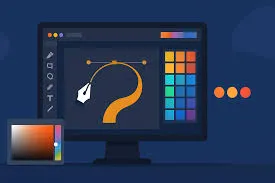Vector design work forms the backbone of my creative output, from corporate branding to digital illustrations. Adobe Illustrator has been my primary tool for over a decade, evolving alongside my career through countless logos, packaging designs, and marketing materials. After extensive use of Illustrator 2025 across diverse projects, I can detail how Adobe’s latest iteration refines established workflows while introducing AI-powered features that genuinely transform certain aspects of vector design.
Core Features and Real-World Applications
Illustrator 2025’s most significant addition is the Generative Shape Fill, which uses Adobe Firefly to create complex vector patterns and textures from text prompts. During a recent packaging project for an organic food brand, I needed intricate botanical patterns that would typically require hours of manual drawing. Typing “delicate wildflower meadow with butterflies” generated multiple vector options that maintained perfect scalability. The AI understood context remarkably well – adjusting prompts with terms like “minimalist” or “art nouveau style” produced appropriately styled results that required minimal cleanup.
The improved Retype feature now identifies fonts with frightening accuracy, even from low-quality images or photos taken at angles. A client recently sent a photo of their storefront sign asking to match the typography for new materials. Retype identified not just the primary font but also suggested similar alternatives from Adobe Fonts, complete with automatic text conversion. This feature alone saved hours of manual font matching that previously involved scrolling through thousands of options.
Live editing capabilities have expanded significantly. The ability to edit repeated objects simultaneously through the new Smart Patterns means changes propagate instantly across entire designs. Creating a repeating geometric pattern for textile design, I could adjust one element and watch the entire pattern update in real-time. This responsive editing eliminated the tedious process of manually updating each instance or rebuilding patterns from scratch.
The Mockup feature integrates directly within Illustrator, eliminating the need to switch to Photoshop for presentation graphics. Applying logos to product packaging, signage, or apparel happens directly in the vector environment. Testing showed accurate perspective matching and lighting effects that previously required complex workarounds or additional software. While not replacing dedicated mockup tools entirely, it handles 80% of client presentation needs efficiently.
Performance Analysis and Metrics
Performance improvements in 2025 feel substantial compared to previous versions. On my workstation (Intel Core i9-12900K, 32GB RAM, RTX 3080), complex documents with thousands of anchor points maintain smooth pan and zoom at 60+ fps. GPU acceleration finally feels properly implemented – operations that previously caused stuttering now execute flawlessly.
Memory management shows marked improvement. Documents that consumed 8-10GB RAM in Illustrator 2024 now use 5-7GB for identical complexity. This efficiency enables working with multiple complex documents simultaneously without system strain. The autosave feature no longer causes noticeable performance hiccups, addressing a long-standing complaint.
File operations demonstrate variable performance. Native AI files save 30-40% faster than previous versions. However, exporting to various formats shows mixed results. PDF export maintains speed improvements, while SVG export occasionally takes longer due to new optimization options. Large raster effect processing benefits significantly from GPU acceleration, with gaussian blur or drop shadows rendering 3-4x faster.
The Creative Cloud integration impacts performance both positively and negatively. Cloud document sync works seamlessly, enabling instant access across devices. However, the constant authentication checks and feature validation create occasional delays. Working offline remains possible but disables certain AI-powered features that require server processing.
Detailed Competitor Comparison
CorelDRAW 2025 offers competitive features at a lower price point with perpetual licensing. Its PowerTRACE tool rivals Illustrator’s Image Trace, and the non-destructive effects provide similar flexibility. However, Illustrator’s industry dominance means better file compatibility when collaborating. CorelDRAW’s $649 one-time purchase appeals financially, but Illustrator’s continuous updates and cloud integration provide advantages for collaborative workflows.
Affinity Designer 2 presents the strongest alternative at $69.99 without subscription. The performance often exceeds Illustrator’s, especially with complex documents. The StudioLink feature allowing instant switching between vector and raster personas impressed during testing. However, Illustrator’s deeper feature set, particularly the new AI tools and extensive third-party support, maintains its professional edge. Affinity suits freelancers avoiding subscriptions, while Illustrator serves agency environments better.
Inkscape provides remarkable capabilities for free, making it attractive for beginners and budget-conscious users. Recent updates improved the interface significantly, and basic vector operations match Illustrator’s quality. However, the lack of CMYK support, limited typography tools, and absent cloud features restrict professional use. Illustrator’s polish and comprehensive toolset justify its cost for commercial work.
Figma revolutionizes collaborative design but focuses on UI/UX rather than general illustration. The real-time collaboration exceeds anything Illustrator offers, and the web-based approach enables true platform independence. For logo design and print work, Illustrator’s specialized tools remain superior. Many designers use both – Figma for digital design, Illustrator for branding and print.
Platform-Specific Considerations
Cross-platform support covers Windows and macOS with near feature parity, though Mac optimization typically leads by a few months. The Windows version finally matches Mac performance after years of disparity. Apple Silicon native support transforms performance on M1/M2 Macs, with operations executing 40-50% faster than Intel equivalents. This optimization makes MacBook Pros viable for heavy illustration work previously requiring desktop power.
iPad compatibility through Illustrator for iPad continues improving but remains limited compared to desktop versions. Basic vector work translates well to touch, but complex path operations and text handling frustrate. The apps serve different purposes – desktop for production work, iPad for sketching and simple edits. File compatibility between versions works reliably.
Web version development proceeds slowly. The beta browser-based Illustrator handles basic tasks but lacks the performance and features for professional work. This limitation contrasts sharply with competitors like Figma operating entirely in browsers. Adobe’s commitment to desktop-first development shows in the web version’s limitations.
Technical Requirements and Workflow
Official requirements specify 8GB RAM minimum, but comfortable operation demands 16GB with 32GB recommended for complex illustrations. GPU acceleration requires 4GB VRAM minimum, with 8GB+ providing noticeable improvements. SSD storage dramatically improves launch times and file operations compared to traditional drives.
Initial learning curve remains steep for newcomers. The interface presents hundreds of tools and panels that overwhelm initially. However, workspace customization allows hiding unnecessary elements. The contextual task bar in 2025 helps surface relevant tools based on current selections. Expecting 2-3 months to achieve proficiency and years to master advanced techniques remains realistic.
Creative Cloud integration streamlines asset management but requires constant internet connectivity for full functionality. Libraries sync across applications, enabling consistent brand assets. The version history feature saved projects multiple times when experiments went wrong. However, the subscription requirement and cloud dependency frustrate users preferring standalone software.
Best Practices From Extensive Usage
Organizing artwork with proper layer structure prevents chaos in complex projects. Using sublayers for different design elements – typography, imagery, backgrounds – enables efficient editing. The new layer search function helps navigate documents with hundreds of layers. Color-coding layers by content type accelerates workflow significantly.
Utilizing symbols for repeated elements reduces file size and improves performance. Converting logos, icons, or decorative elements to symbols enables global updates while maintaining small file sizes. The improved symbol sprayer tools create organic distributions that feel less mechanical than previous versions.
Keyboard customization transforms productivity once muscle memory develops. Mapping frequently used tools to single keys eliminates tool palette hunting. The new quick actions feature allows creating macro-like operations for repetitive tasks. Investment in learning shortcuts pays dividends through improved speed.
Regular Creative Cloud library maintenance prevents asset chaos. Organizing brand assets, color swatches, and commonly used graphics into structured libraries ensures consistency across projects. The ability to share libraries with team members standardizes brand implementation without manual asset distribution.
Business Value and ROI Analysis
Adobe’s subscription model at $31.49/month for Illustrator alone or $59.99/month for full Creative Cloud represents ongoing investment rather than one-time purchase. For professional designers billing $75-150/hour, the monthly cost recovers within the first billable hour. The continuous updates ensure access to latest features without upgrade fees.
Agencies find value through team collaboration features and enterprise admin controls. The ability to manage licenses, share assets, and maintain version control justifies higher costs compared to alternatives. Training costs reduce when hiring designers already familiar with industry-standard tools.
Freelancers face harder calculations. The monthly subscription impacts cash flow during slow periods. However, Illustrator proficiency remains highly marketable, with many job postings specifically requesting Adobe skills. The software pays for itself through increased job opportunities and higher rates.
Students benefit from significant educational discounts at $19.99/month for all Creative Cloud apps. Learning industry-standard tools before entering the workforce provides competitive advantages. The investment in skills development often returns through better job placements.
Who Should Use Illustrator 2025
Professional graphic designers working in print, branding, and digital illustration find Illustrator essential. The industry adoption means skills transfer between employers seamlessly. Logo designers particularly benefit from precise vector tools and extensive typography controls. The new AI features accelerate concept development without replacing designer creativity.
Marketing teams creating varied collateral discover comprehensive tools for all needs. From social media graphics to trade show banners, Illustrator handles diverse output requirements. The mockup features reduce dependence on separate presentation tools. Integration with other Creative Cloud apps streamlines complete campaign development.
Hobbyists and occasional users should carefully evaluate alternatives. The subscription cost hurts without regular use, and free options like Inkscape handle basic needs. Starting with alternatives and moving to Illustrator when professional needs arise makes financial sense.
Small businesses on tight budgets face difficult decisions. Illustrator’s capabilities may exceed needs while straining budgets. Affinity Designer provides similar quality at lower cost for many use cases. However, Illustrator becomes necessary when working with agencies or print shops expecting Adobe files.
Final Verdict
Adobe Illustrator 2025 crack successfully evolves the industry standard with meaningful AI integration and performance improvements. The new generative features accelerate certain workflows without compromising professional control. For designers embedded in creative workflows, the updates justify continued subscription despite the ongoing costs.
Frustrations persist: the subscription-only model alienates users preferring ownership, occasional stability issues require work interruptions, and the learning curve remains daunting. The Creative Cloud dependency creates vendor lock-in that some find uncomfortable. These issues affect user satisfaction but don’t diminish Illustrator’s capabilities.
For professional designers and agencies, Illustrator 2025 maintains its essential status through combination of powerful features, industry compatibility, and continuous innovation. While alternatives gain ground through aggressive pricing and focused features, Illustrator’s comprehensive toolset and ecosystem integration create sustainable advantages.
The decision ultimately depends on professional needs and financial circumstances. Those building design careers need Illustrator proficiency for marketability. Established professionals benefit from efficiency gains and new capabilities. However, casual users and budget-conscious small businesses should seriously evaluate whether alternatives meet their needs. For appropriate users, Illustrator 2025 delivers professional tools that continue defining industry standards while pushing creative boundaries through thoughtful AI integration.



